

Information Found Inside Meteorite Gives Insight To Earth's Freezing Core. Researchers have captured information stored inside tiny magnetic regions in meteorite samples using a detailed imaging technique at the BESSY II synchrotron in Berlin.
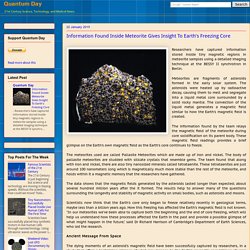
Meteorites are fragments of asteroids formed in the early solar system. The asteroids were heated up by radioactive decay, causing them to melt and segregate into a liquid metal core surrounded by a solid rocky mantle. The convection of the liquid metal generates a magnetic field similar to how the Earth's magnetic field is created. Apophis: The Asteroid That Could Smash Into The Earth. NEO Earth Close Approaches. Asteroid Mining Mission Revealed by Planetary Resources, Inc. Planetary Resources shows off full-scale asteroid mining prototype.
Chris Lewicki and the Arkyd-100 prototype Image Gallery (7 images) Last year, we took an in-depth look at Planetary Resources’ asteroid mining plans.
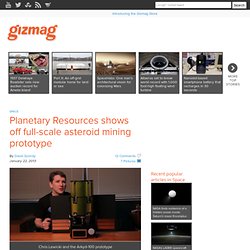
Plan to Capture an Asteroid Runs Into Politics. But the space agency has encountered a stubborn technical problem: Congressional Republicans.
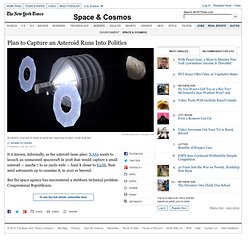
Normally, there is bipartisan support (or disapproval) in Congress for NASA’s bolder plans, particularly when they involve human spaceflight. What squabbling does take place tends to pit lawmakers from states with big NASA presences, like Florida and Texas, against those with fewer vested interests. This month, however, the science committee in the Republican-controlled House voted to bar NASA from pursuing that faraway rock. NASA Plans Asteroid Mining Mission - Space News. August 9, 2013 Image Caption: This is an artist's concept of NASA's OSIRIS-REx spacecraft preparing to take a sample from asteroid Bennu.

Credit: NASA/Goddard/Chris Meaney [ Watch The Video: OSIRIS-REx Investigates Asteroid Bennu ] Brett Smith for redOrbit.com – Your Universe Online NASA announced yesterday that it will be launching a spacecraft in 2016 with the intent of laying the groundwork for future expeditions to mine asteroids. The space agency added that the mission – dubbed the Origins, Spectral Interpretation, Resource Identification, Security and Regolith Explorer (OSIRIS- REx) – is scheduled to visit the asteroid Bennu and enable scientists to better study the origins of the universe by taking a sample of the 1,600-foot wide asteroid. After traveling through the solar system for two years, the spacecraft is scheduled to arrive at Bennu in October 2018.
NASA takes asteroid mining seriously; funds viability study. Only five months after Google’s billionaire co-founders and filmmaker James Cameron officially launched their asteroid mining focused Planetary Resources company, the U.S.
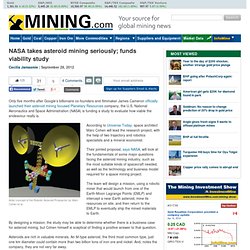
National Aeronautics and Space Administration (NASA) is funding a study to evaluate how viable the endeavour really is. According to Universe Today, space architect Marc Cohen will lead the research project, with the help of two trajectory and robotics specialists and a mineral economist. Their jointed proposal, says NASA, will look at the fundamentals of some major questions facing the asteroid mining industry, such as the most suitable kinds of spacecraft needed, as well as the technology and business model required for a space mining project.
Impact: Earth! Asteroid-mining company seeks $20 million in funding. - latimes.com. A group of private entrepreneurs is raising $20 million to fund the first stage of a mission to identify asteroids close to Earth and mine them for valuable materials.
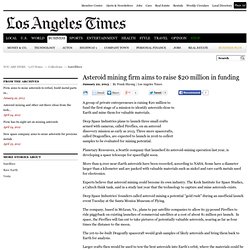
Deep Space Industries plans to launch three small crafts armed with cameras, called Fireflies, on an asteroid discovery mission as early as 2015. Three more spacecrafts, called Dragonflies, are expected to launch in 2016 to collect samples to be evaluated for mining potential. Combating the asteroid threat: Column. For a while, earlier this year, it seemed as if we were completely at the mercy of killer asteroids.
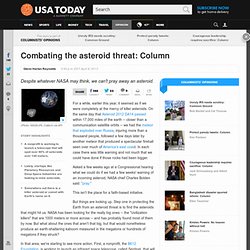
On the same day that Asteroid 2012 DA14 passed within 17,000 miles of the earth -- closer than a communication satellite orbits -- we had the meteor that exploded over Russia, injuring more than a thousand people, followed a few days later by another meteor that produced a spectacular fireball seen over much of America's east coast. In each case there was little warning and not much that we could have done if those rocks had been bigger. Asked a few weeks ago at a Congressional hearing what we could do if we had a few weeks' warning of an incoming asteroid, NASA chief Charles Bolden said: "pray. " This isn't the place for a faith-based initiative. But things are looking up. In that area, we're starting to see more action. Now they're moving ahead with considerable support.
Rosetta's 67P Is The Result Of A Collision Of Two Comets. Ever since we’ve been able to get closer looks at comets in our Solar System, we’ve noticed something a little puzzling.
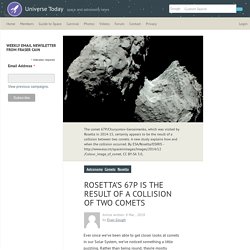
Rather than being round, they’re mostly elongated or multi-lobed. This is certainly true of Comet 67P/Churyumov-Gerasimenko (67P or Chury for short.) A new paper from an international team coordinated by Patrick Michel at France’s CNRS explains how they form this way. An artist’s illustration of the spacecraft Rosetta and the Philae lander at comet 67P C-G. Image: By European Space Agency – Rosetta and Philae at comet, CC BY-SA 3.0-igo, Though Rosetta’s pictures of 67P are the most detailed comet pictures we have, other spacecraft have visited other comets.
In order for comets to merge and come out looking the way they do, they would have to merge very slowly, or else they would explode. The problem with this theory is, how could bodies like 67P have survived for so long? Geysers of dust and gas shooting off the comet’s nucleus are called jets. John S Lewis. Newly discovered asteroid will narrowly miss Earth on Sunday.
A depiction of the orbit of asteroid 2014 RC around the sun.
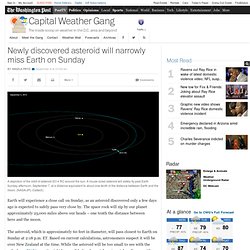
A house-sized asteroid will safely fly past Earth Sunday afternoon, September 7, at a distance equivalent to about one-tenth of the distance between Earth and the moon. (NASA/JPL-Caltech) Earth will experience a close call on Sunday, as an asteroid discovered only a few days ago is expected to safely pass very close by.
The space rock will zip by our planet approximately 25,000 miles above our heads – one tenth the distance between here and the moon. The asteroid, which is approximately 60 feet in diameter, will pass closest to Earth on Sunday at 2:18 p.m. A depiction of the passage of asteroid 2014 RC past Earth on September 7, 2014. While 2014 RC will pass extremely close to the orbiting height of our planet’s geosynchronous satellites, which are parked at a height of 22,000 miles, NASA says it does not pose any threat to the satellites because of its path below Earth and the satellite orbit ring.
Better Asteroid Detection Needed, Experts Tell Senate Panel. To Planetarium Director, Siberia Meteor Showed Value of Science. Dealing with asteroid strikes: A close shave. Asteroid defence: The real star war. To Planetarium Director, Siberia Meteor Showed Value of Science.